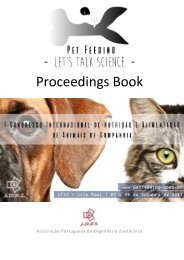Book of Proceedings I PetFeeding
Book of Proceedings I PetFeeding
Book of Proceedings I PetFeeding
Create successful ePaper yourself
Turn your PDF publications into a flip-book with our unique Google optimized e-Paper software.
35<br />
Orphan feeding and nutrition <strong>of</strong> the orphan kitten and puppy,<br />
birth to weaning<br />
Galena Quist<br />
Rybachuk, PhD, Res. ECVCN<br />
Orphaned puppies and kittens, first and foremost, should be stabilized, and thus, treated for<br />
hypothermia, dehydration and hypoglycemia, as well as receive a complete physical<br />
examination (e.g. parasites, ocular and respiratory infections, wounds or any congenital<br />
malformations) before being fed. While warming up, warm water with electrolytes and sugar<br />
are the first in nutritional support neonate should receive.<br />
In severely hypovolemic patients, initial shock doses (30-45 ml/kg dogs or 20-30 ml/kg<br />
cats) <strong>of</strong> balanced crystalloid (lactated Ringer’s or 0.9% NaCl), ideally administered IV<br />
(peripheral or central), can be used. Rehydration is achieved slower via subcutaneous route, but<br />
it’s <strong>of</strong>ten the only option. Oral rehydration is contraindicated in hypothermic patients.<br />
Orogastric feeding tube, 5 or 8 French red rubber, or voluntary oral intake can be used only if<br />
neonate is normothermic and minimally dehydrated. Normal stomach volume is approximately<br />
4 to 5 ml per 100 g body weight (Macintire, 1999; Little, 2013). Maintenance fluid requirement<br />
<strong>of</strong> neonates (120-180 ml/kg/day) is much higher than in older pediatric patients or adults due<br />
to higher surface to weight ratio, lack <strong>of</strong> body fat, higher metabolic rate, increased respiratory<br />
rate and thus, loses, and higher extracellular fluid content (Macintire, 2008; Hoskins, Fluid<br />
therapy in the puppy and kitten, 1995).<br />
Hypoglycemia complicated by inefficient hepatic gluconeogenesis, immature glucose<br />
feedback and decreased glycogen stores can result in neurodegeneration and cardiovascular<br />
collapse since brain and myocardium depend on carbohydrate metabolism in a neonate (Boluyt,<br />
2006). Dextrose is administered buccally (0.5–1.5 mL/kg <strong>of</strong> 50% dextrose) or as 2.5%–5% in<br />
IV fluids (Lee, 2015; Davidson, 2014). The subsequent steps will require finding a caretaker,<br />
setting up enclosure, selecting the milk replacer and gradual initiation <strong>of</strong> nutritional support<br />
avoiding complications such as commensal infections, diarrhea, aspiration pneumonia, and<br />
refeeding syndrome. The first 2 days are critical.<br />
Foster queen or bitch are ideal caretakers, but not <strong>of</strong>ten available. Successful foster mother,<br />
will accept the neonate immediately allowing them to nurse, but the interaction and weight gain<br />
should be monitored closely in the first days. Human foster parents raise most orphan kittens<br />
and puppies. Conversely, majority <strong>of</strong> puppy and kitten neonatal deaths are not due to infectious<br />
diseases, but rather to caregiver error due to inadequate knowledge. Incorrect feeding and<br />
husbandry techniques, delay in identifying a problem or providing treatment result in reduced<br />
survival. Motherless kittens and puppies have vital requirements, they need to be kept warm,<br />
clean, and on safe bedding, be fed properly and stimulated to urinate and defecate, as well as<br />
be well socialized.



